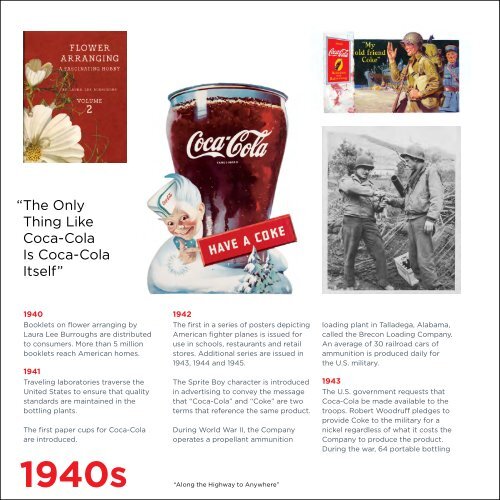Coca-Cola_125_years_booklet
You also want an ePaper? Increase the reach of your titles
YUMPU automatically turns print PDFs into web optimized ePapers that Google loves.
“The Only<br />
Thing Like<br />
<strong>Coca</strong>‐<strong>Cola</strong><br />
Is <strong>Coca</strong>‐<strong>Cola</strong><br />
Itself”<br />
“Where There’s<br />
Coke, There’s<br />
Hospitality”<br />
1940<br />
Booklets on flower arranging by<br />
Laura Lee Burroughs are distributed<br />
to consumers. More than 5 million<br />
<strong>booklet</strong>s reach American homes.<br />
1941<br />
Traveling laboratories traverse the<br />
United States to ensure that quality<br />
standards are maintained in the<br />
bottling plants.<br />
The first paper cups for <strong>Coca</strong>‐<strong>Cola</strong><br />
are introduced.<br />
1942<br />
The first in a series of posters depicting<br />
American fighter planes is issued for<br />
use in schools, restaurants and retail<br />
stores. Additional series are issued in<br />
1943, 1944 and 1945.<br />
The Sprite Boy character is introduced<br />
in advertising to convey the message<br />
that “<strong>Coca</strong>‐<strong>Cola</strong>” and “Coke” are two<br />
terms that reference the same product.<br />
During World War II, the Company<br />
operates a propellant ammunition<br />
loading plant in Talladega, Alabama,<br />
called the Brecon Loading Company.<br />
An average of 30 railroad cars of<br />
ammunition is produced daily for<br />
the U.S. military.<br />
1943<br />
The U.S. government requests that<br />
<strong>Coca</strong>‐<strong>Cola</strong> be made available to the<br />
troops. Robert Woodruff pledges to<br />
provide Coke to the military for a<br />
nickel regardless of what it costs the<br />
Company to produce the product.<br />
During the war, 64 portable bottling<br />
plants are sent to Asia, Europe and<br />
North Africa. More than 5 billion<br />
bottles of <strong>Coca</strong>‐<strong>Cola</strong> are distributed.<br />
1945<br />
“Coke” becomes a registered<br />
trademark of The <strong>Coca</strong>‐<strong>Cola</strong> Company.<br />
1946<br />
The “Yes” poster with artwork by<br />
Haddon Sundblom is released. The<br />
poster wins multiple design awards.<br />
The first price increase from the 5 cent<br />
<strong>Coca</strong>‐<strong>Cola</strong> occurs in California. The<br />
price gradually rises in other markets,<br />
ending the decades-old “nickel Coke.”<br />
1947<br />
The famous industrial designer<br />
Raymond Loewy develops a new<br />
fountain dispenser—the Dole Deluxe.<br />
The red disc metal sign is introduced<br />
in diameters ranging from 12 to 48<br />
inches. A later version of the sign<br />
includes the famous contour bottle.<br />
1948<br />
<strong>Coca</strong>‐<strong>Cola</strong> is introduced in Egypt.<br />
A neon spectacular sign is installed<br />
in downtown Atlanta at a cost of<br />
$50,000. It remains in place until 1981.<br />
1940s<br />
“Along the Highway to Anywhere”


